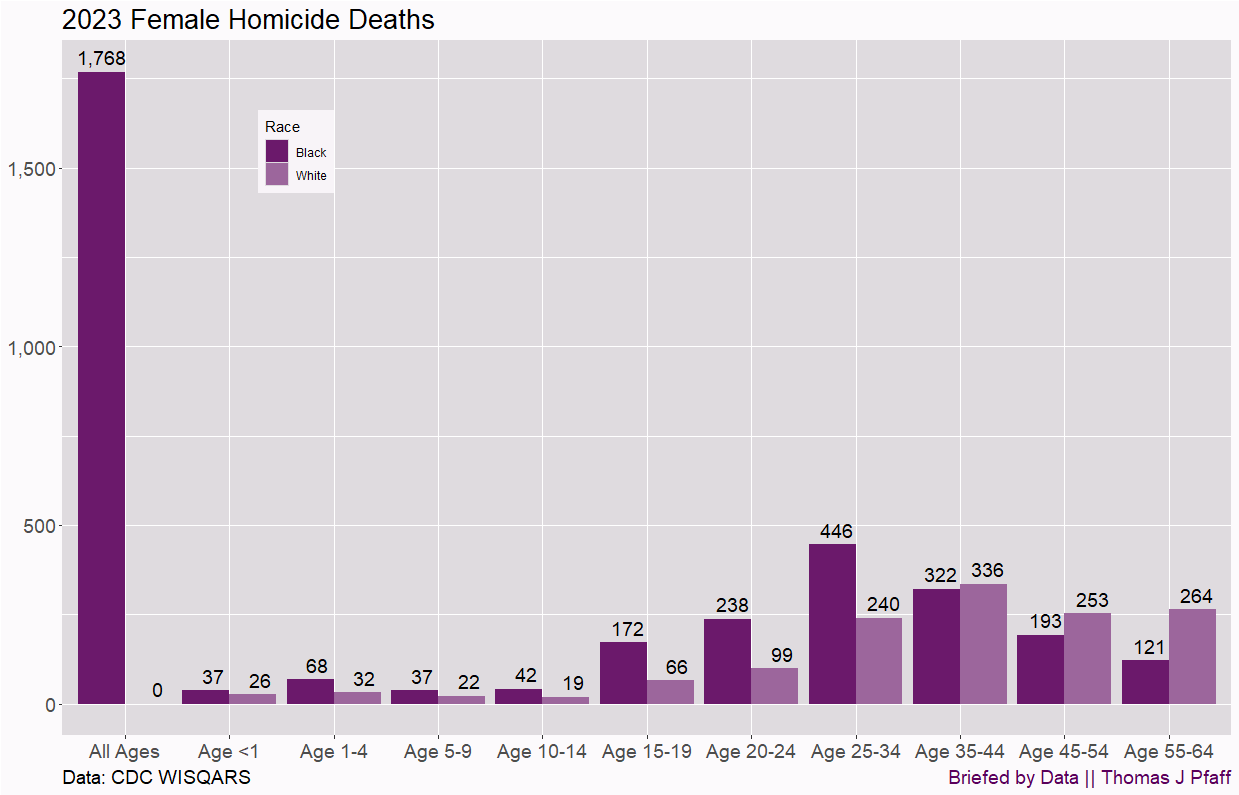I got a comment on last Tuesday’s post, Demographics and firearm deaths that deserved a follow-up post. Here is the comment:
When I've heard the Black/White homicide/suicide disparity discussed, it was discussed as if many of these deaths have a similar underlying cause and different manifestation. Specifically, there is a hypothesis that for men who reach a point where they become self-destructive, this becomes overt self-harm in most communities, but in (predominantly Black) communities with chronic violence, this becomes choosing a path that is self-destructive in the long term, e.g., criminal lifestyles.
The implicit question here is excellent. The idea, if true, would be that males are being self-destructive (I’d say more aggressive) and that Black and White males simply focus this aggression differently. One towards homicides and the other suicides. I’ll call this the aggression hypothesis. If this is the case, then we would see similar patterns by age group. Generally, males become less aggressive as they age, and so homicides and suicides would go down but stay roughly in the same ratios between Black and White males. It wasn’t much extra work to collect the female data, so I did that too. Also keep in mind that the general population ratio is about 4.5:1 White to Black. Let’s go to the data and see what it has to say.
Black and White male homicides by age
Figure 1 is 2023 homicides for both Black and White males. Note that most homicides stay within groups (90%+) but not all. The patterns for the two groups are different. The ratios for the age groups Age 15-19, Age 20-24, Age 25-34, Age 35-44, and Age 45-54 are 6.5 Black to 1 White, 6.7 to 1, 4.8 to 1, 2.4 to 1, and 1.5 to 1, respectively. Black homicides start at a much earlier age and never fall close to the population ratio of about 4.5 to 1 White to Black. Now, maybe the suicide rates are similar but in reverse.

Black and White male suicides by age
Figure 2 is the graph for male suicides. The pattern here is very different from the graph for homicides. The Black pattern is what we might expect under the aggression hypothesis, peaking in the age range 25-34. On the other hand, the peak age range for White male suicides is 55-64.
The ratios for the age groups Age 15-19, Age 20-24, Age 25-34, Age 35-44, Age 45-54, and Age 55-64 are 3.9 White to 1 Black, 3.7 to 1, 4.5 to 1, 8.3 to 1, 12.8 to 1, and 17.3 to 1. From age 15 to 34, the ratios are close enough to the general population, but then they grow. For White males, suicide is a very different problem than that for Black males, being something that impacts them much later in life.

I’d say the aggression hypothesis is not likely to hold true. There may be other factors to adjust for, say socio-economic factors, that would explain the differences, but based on this data, something very different is going on within Black and White communities that is not explained by male aggression manifesting differently.
A follow-up question is then, are there similar differences for females? Let’s go to the data.
Black and White female homicides by age
Figure 3 is a little tricky to interpret as women are more likely to be killed by males. Interestingly, the 0 for White female All Ages is because for All Ages, homicides aren’t a top 20 cause of death for White females. We still get disproportionate Black female homicides, but at least Black female homicides fall below White female homicides by age 45. It is still not in proportion to the general population, but at least it isn’t completely reversed. In the end, I’m not sure what to make of this beyond that it is influenced by Black male violence more than anything.

Black and White female suicides by age
Figure 4 is rather astonishing. By and large, Black females don’t kill themselves. The overall ratio is 10 White to 1 Black female suicide. The White female pattern here mirrors that for White males. I would say this is further evidence against the aggression hypothesis and in favor of cultural differences of some sort.
I would also argue that the suicide patterns go against the White privilege narrative (I’ll expect an unsubscribe or two for saying this when I’d really rather someone argue against me). If life was so difficult for Black people and so great for White people,, then why are White people, both males and females, killing themselves disproportionately as compared to Black people? I’m sure there are other factors; there always are (this is one of my data rules: always consider other factors as single-factor explanations are rare), but on its face this doesn’t mesh with the left’s narrative.

Please share and like
Sharing and liking posts attracts new readers and boosts algorithm performance. I appreciate everything you do to support Briefed by Data.
Comments
Please let me know if you believe I expressed something incorrectly or misinterpreted the data. I'd rather know the truth and understand the world than be correct. I welcome comments and disagreement. We should all be forced to express our opinions and change our minds, but we should also know how to respectfully disagree and move on. Send me article ideas, feedback, or other thoughts at briefedbydata@substack.com.
Bio
I am a tenured mathematics professor at Ithaca College (PhD Math: Stochastic Processes, MS Applied Statistics, MS Math, BS Math, BS Exercise Science), and I consider myself an accidental academic (opinions are my own). I'm a gardener, drummer, rower, runner, inline skater, 46er, and R user. I’ve written the textbooks “R for College Mathematics and Statistics” and “Applied Calculus with R.” I welcome any collaborations.





I'm happy to have inspired the doing of an analysis.